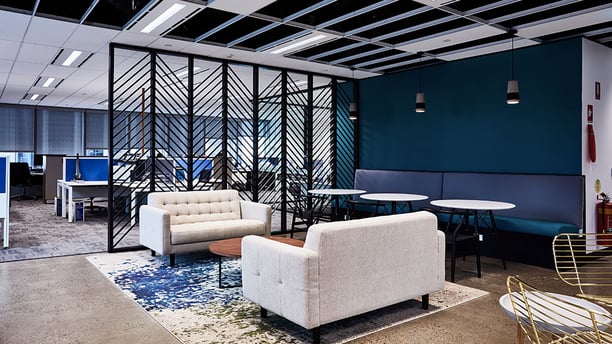The Future of Commercial Design
July 29, 2021

It’s hard to imagine a post-COVID office space, even as companies reopen and figure out how work will work. People are now much more aware of their environment’s cleanliness as they attempt to keep safe while socializing and working from a distance. Some still work remotely, but many are starting to come into the office.
Relatedly, COVID has accelerated the societal push toward increased regard for mental health and inclusion, whether at work or not. We all realized the importance of taking some time to care for ourselves and others after experiencing the effects of the pandemic.
Fortunately, commercial interior design can adapt — and it is adapting. Several emerging trends clearly take these and other factors into account. Here are three big trends defining the future of commercial design.
Trend 1: Color Theory
Color theory is simply the art and science of using color. In design, it’s a collection of guidelines that explain how people perceive and emotionally respond to color — therefore, it helps designers convey information and elicit emotions from people through color.
For example, certain colors could subtly influence people to be more productive or relax. Obviously, you’d want colors that promote productivity and creativity in meeting rooms and individual offices, whereas colors that relax would be better suited for social areas.
Of course, brands are also implementing their brand colors in design aspects. This helps maintain company cohesiveness — and cohesiveness is especially important when employee schedules mix in-office and remote work.
Trend 2: An Increased Focus on Social Settings
Working remotely was the norm in 2020. As restrictions lighten, not all companies have returned to the office. Many have implemented hybrid schedules — some in-office work days and some work-from-home days.
As a result, employees are around fewer people with whom to socialize on the days of the week they work from home. Naturally, this trend is making social settings increasingly important for the in-person work location itself. On days that employees work in the office, they can easily capitalize on in-person collaboration and meetings.
The isolated individual office and the rows upon rows of desk space are becoming obsolete. These stand in the way of more open collaboration and socialization that employees are seeking in their office environment — while maintaining safe distancing, of course.
Break rooms, kitchens, and social spaces in the office are on the rise as well. These areas offer more casual spaces for employees to exchange ideas or simply relax, which can benefit the company. Google is a classic example with its game room, containing games like table tennis and foosball.
You don’t necessarily need a game room for your office, but creating spaces for socialization can help everyone recover from the isolation that comes with working remotely.
Trend 3: Sensorial Enablers
The last big trend is that companies are adding inclusive experience centers in their offices to promote mental health. Employer and employee interests align here — some companies are finding that focusing on these helps their bottom line.
Meditation rooms are a good example. These rooms mix light, sound, and tech to provide a calming space for employees to relax and relieve stress — whether work or personal. Less stress makes a more productive employee. Companies as large as Google, Nike, and Yahoo have added these to their corporate offices in recent years.
Nap pods are another type of experience center that companies like those we mentioned are experimenting with. Plenty of employees are no strangers to sleep deprivation. According to the Sleep Foundation, nearly one-third of American adults are impacted by sleep deprivation. There are many potential reasons for an employee to not get enough sleep at night, including work obligations, sleep disorders, and lifestyle choices. Even without sleep deprivation, studies have shown that short naps can recharge the body and help people refocus on work. Some employers are adding nap pods or even entire nap rooms to their offices to help combat this issue.
Firms are also creating spaces that affirm company culture. People-first design elements from comfortable and ergonomic furniture to photography and branded elements in artwork are appearing in more offices. Mission, vision, and value statements are also placed in prominent locations to motivate employees and increase cohesiveness in the company.
Conclusion
At Cochran & Mann, we have over 30 years of trend-setting success delivering excellent value and craftsmanship in commercial design. Look no further than 2050 M Street in Washington, D.C., for whom we painted and provided wall covering services for their entire 338,000-square foot building.
If you need custom commercial design services, we’re happy to talk more about your needs. Request your free quote today.




